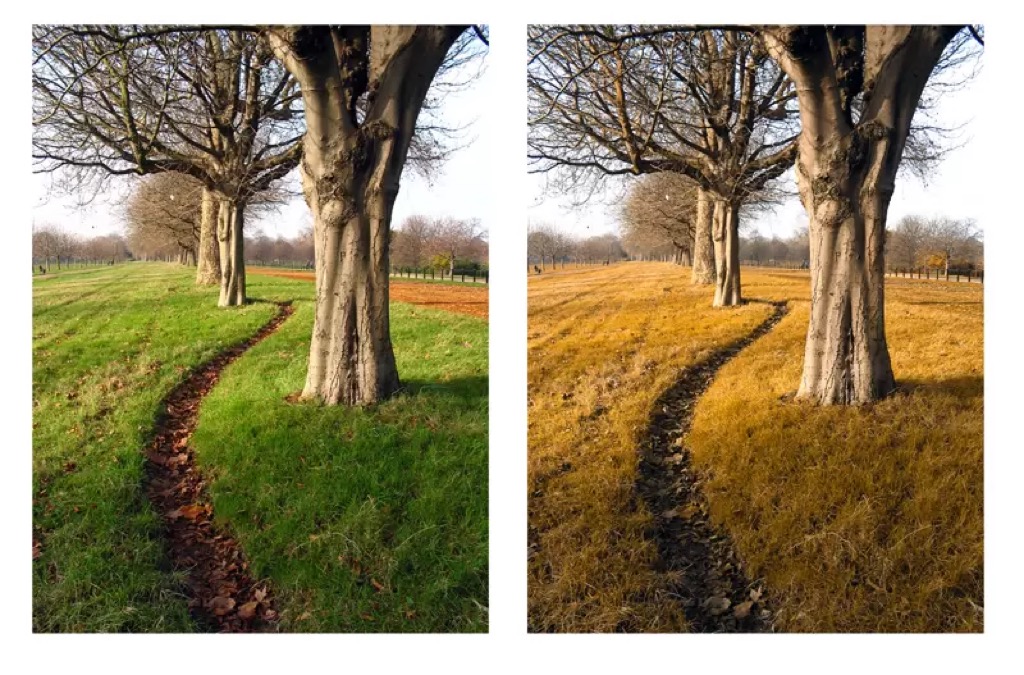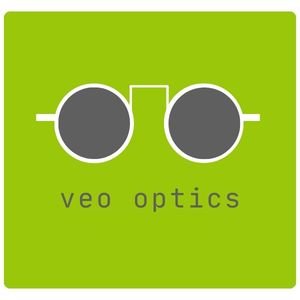
These two photos look identical to me. What I see looks like the photo on the right.
I have mild deuteranomaly – red-green colorblindness. Eight percent of men are red-green colorblind. (Almost no women. It’s a genetic thing.) It’s hard to describe, because my world has a full spectrum of colors – “colorblind” does not mean the world is gray. But as you can tell by looking at those photos, I don’t see the same colors you do. When my family sees pictures like that, they shake their heads and say “Ohhhh . . . ” and look sad about how damaged I am.
Ten years ago I discovered new technology for tinted glasses that correct my color blindness so I can see colors normally. I had to set them aside for a few years because they weren’t available with prescription lenses. Thanks to the good folks at Veo Optics in Petaluma, I was finally able to get glasses with Vino Optics prescription color blindness lenses.
When I wear the glasses, those two pictures look very different. They’re closer to what you see. At least I think they are. It’s impossible to be sure.

Fun fact: when I hold the glasses in my hand, they look purple, just like they do to you. When I put them on and look at myself in a mirror, the lenses are 100% transparent. It looks to me like the lenses are clear glass – like, I don’t see the purple at all. I think there’s a way that the optics of that makes sense but it makes my brain hurt to try to work it out.
The lenses appear to be tinted purple but there’s more to it than that. This is an outgrowth of research done for the medical profession to develop glasses giving clearer views of veins, blood oxygen level, bruising, flushing, and other blood physiology. The lenses adjust the color signals hitting the eyes in very specific ways. The effect on color blindness is a side effect, not the intended purpose.
With the glasses I can pass the Ishihara color blindness tests, the ones with circles filled with colored blobs and numbers. Without them lots of the circles don’t have numbers and the conclusion is that I have mild-to-medium deuteranomaly.

But passing a test isn’t the point. I’m not trying to become a pilot or firefighter or phlebotomist, where accurate color discrimination is a job requirement. It doesn’t even matter if what I see through the glasses is accurate. When I put on the Vino Optics glasses, the world is more interesting. Reds are completely different than I thought, lighter and brighter, not the dark brownish tint that I normally see. Red leaves pop out on the trees as they change color. Unripe blackberries jump out at me. Fire trucks and red cars look cool.
An even more profound change happens to the greens. See the difference in the color of the grass and bushes in the background of the above pictures? Words can’t express how it feels to look at trees, then put the glasses on and see the leaves change to a completely different color, barely resembling the uncorrected view – while other colors are unchanged.
It’s hard to describe. Greens and reds are richer, yes, but they’re also shifting hues, bringing out contrasts that I had no idea were there. It’s emotional and at times breathtaking.
But color blindness glasses are a niche product. There are a lot of reasons they might not work for you if you’re color blind – and sadly they make a terrible gift because it’s impossible to choose the right ones for someone.
My deuteranomaly is the most common type of color blindness but it is only one of many. There are different corrective lenses for different types of color blindness and there are gradations within each kind that the lenses might or might not address. The glasses will be ineffective if they don’t match what a particular person needs.
It’s worse than that, though. There are three readily available types of color blindness glasses: Enchroma, Vino Optics, and Pilestone. They make the same claims and there are YouTube videos for each of people crying at their first look at a colorful world. Each uses slightly different technology to treat their lenses.
A generalization applies to all of them: they don’t work for everyone and success seems to be wholly unpredictable. Oh, and the reaction videos might be faked or exaggerated. They’re not available in local stores, so the only way to discover whether they’ll help you is to order a pair, try them, send them back if you don’t like the results, and move on to the next one.
I did that years ago. Enchroma glasses did nothing for me. I tried two pairs of Enchroma glasses and nada, no joy, no interesting color shifts, not much of anything at all. The Vino Optics glasses (then marketed under the name Oxy-Iso) were life-changing views of colorful joy.
But I saw anecdotes from people who had exactly the opposite experience – Oxy-Iso glasses didn’t work for them, Enchroma made the world colorful and exciting.
And there’s no shortage of stories from people who got no benefit from any of them.
Maybe you’ll be lucky like me, or maybe it will be a waste of time.
There’s an active Reddit community discussing color blindness because of course there is, there’s a Reddit forum for anything you can imagine. Very vocal people on that forum state unequivocally that color blindness glasses are a scam and no one benefits from them, they’re eyeball placebos.
I don’t think so. During these first few weeks I’m still enjoying the novelty of sliding my new glasses down my nose, then pushing them up and seeing trees change into completely different reds and greens. It makes me giggle.
If you are color blind and you know the name of your condition, there are settings in Windows, Mac, and Quest to adjust the colors on your display for various types of color blindness. (Look in Settings / Accessibility.) There’s an odd side effect, though, which is that whenever you swivel your screen to show something to someone else, they will recoil and ask you if your monitor is broken. That should be trivial, sure, but it’s a weird thing to explain.

The Vino Optics prescription glasses are niche specialty items and the good folks at Veo Optics wrestled with some difficult problems to grind my lenses. I’m grateful to them for sticking with it. It’s a nice place to shop for conventional glasses and frames too. Talk to Jesse. Ask him about color blindness glasses. He might scream involuntarily, but I’ll bet he recovers nicely – their lab learned some tricks from my glasses that will make it easier the next time. Tell them I sent some heart emojis their way – and I could tell they were red.
